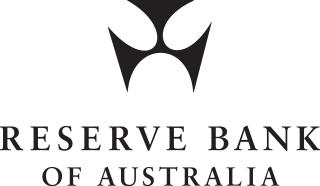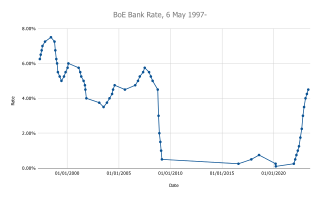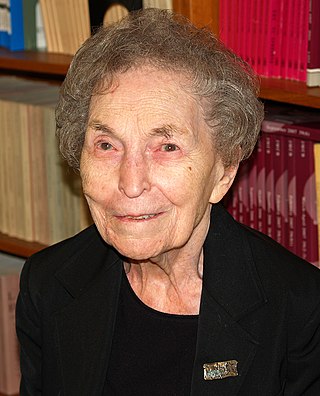Related Research Articles

Monetarism is a school of thought in monetary economics that emphasizes the role of governments in controlling the amount of money in circulation. Monetarist theory asserts that variations in the money supply have major influences on national output in the short run and on price levels over longer periods. Monetarists assert that the objectives of monetary policy are best met by targeting the growth rate of the money supply rather than by engaging in discretionary monetary policy. Monetarism is commonly associated with neoliberalism.

The Federal Reserve Act was passed by the 63rd United States Congress and signed into law by President Woodrow Wilson on December 23, 1913. The law created the Federal Reserve System, the central banking system of the United States.

The causes of the Great Depression in the early 20th century in the United States have been extensively discussed by economists and remain a matter of active debate. They are part of the larger debate about economic crises and recessions. The specific economic events that took place during the Great Depression are well established.

The Reserve Bank of Australia (RBA) is Australia's central bank and banknote issuing authority. It has had this role since 14 January 1960, when the Reserve Bank Act 1959 removed the central banking functions from the Commonwealth Bank.
David Kenneth Miles is a British economist. Born in Swansea, he has spent his working life in London, in teaching, business and the public sector. He is a professor at Imperial College London, and was Chief UK Economist of Morgan Stanley bank from October 2004 to May 2009. He was appointed to the Bank of England's interest-rate-setting Monetary Policy Committee (MPC) from 1 June 2009 to June 2012 and again from June 2012 to 31 August 2015, before being replaced by Gertjan Vlieghe. According to the Bank of England, "As an economist he has focused on the interaction between financial markets and the wider economy.". In December 2020 he was appointed to the main board of the central Bank of Ireland. He was appointed to the Budget Responsibility Committee of the Office for Budget Responsibility (OBR) in December 2021. He took up that role in January 2022.

Cyril John Radcliffe, 1st Viscount Radcliffe, was a British lawyer and Law Lord best known for his role in the Partition of India. He served as the first chancellor of the University of Warwick from its foundation in 1965 to 1977.

The Bank of Korea is the central bank of the Republic of Korea and issuer of Korean Republic won. It was established on 12 June 1950 in Seoul, South Korea.

The Monetary Policy Committee (MPC) is a committee of the Bank of England, which meets for three and a half days, eight times a year, to decide the official interest rate in the United Kingdom.
This history of central banking in the United States encompasses various bank regulations, from early wildcat banking practices through the present Federal Reserve System.

The Federal Reserve System has faced various criticisms since it was authorized in 1913. Nobel laureate economist Milton Friedman and his fellow monetarist Anna Schwartz criticized the Fed's response to the Wall Street Crash of 1929 arguing that it greatly exacerbated the Great Depression. More recent prominent critics include former Congressman Ron Paul.
National Girobank was a British public sector financial institution run by the General Post Office that opened for business in October 1968. It started life as National Giro then National Girobank and finally Girobank plc before being absorbed into Alliance & Leicester plc in 2003.

Anna Jacobson Schwartz was an American economist who worked at the National Bureau of Economic Research in New York City and a writer for The New York Times. Paul Krugman has said that Schwartz is "one of the world's greatest monetary scholars."[1]
The National Monetary Commission was a U.S. congressional commission created by the Aldrich–Vreeland Act of 1908. After the Panic of 1907, the Commission studied the banking laws of the United States, and the leading countries of Europe. The chairman of the Commission, Senator Nelson Aldrich, a Republican leader in the Senate, personally led a team of experts to major European capitals. They were stunned to discover how much more efficient the European financial system appeared to be and how much more important than the dollar were the pound, the franc and the mark in international trade. The Commission's reports and recommendations became one of the principal bases in the enactment of the Federal Reserve Act of 1913 which created the modern Federal Reserve system.

Charles Albert Eric Goodhart, is a British economist. His career can be divided into two sections: his term with the Bank of England and its associated public policy; and his academic work with the London School of Economics. Charles Goodhart's work focuses on central bank governance practices and monetary frameworks. He also conducted academic research into foreign exchange markets. He is best known as the founder of Goodhart's Law, which states: "When a measure becomes a target, it ceases to be a good measure."

A Monetary History of the United States, 1867–1960 is a book written in 1963 by Nobel Prize–winning economist Milton Friedman and Anna J. Schwartz. It uses historical time series and economic analysis to argue the then-novel proposition that changes in the money supply profoundly influenced the U.S. economy, especially the behavior of economic fluctuations. The implication they draw is that changes in the money supply had unintended adverse effects, and that sound monetary policy is necessary for economic stability. Orthodox economic historians see it as one of the most influential economics books of the century. The chapter dealing with the causes of the Great Depression was published as a stand-alone book titled The Great Contraction, 1929–1933.
Kjell G. Nyborg is a financial economist. Since 2009, he has been a Chaired Professor of Finance at the University of Zurich, Department of Banking and Finance, where he is currently also Vice Director. In addition, he is a Senior Chair of the Swiss Finance Institute (SFI), a Research Fellow of the Centre for Economic Policy Research (CEPR), and a Fellow of the Royal Society of Arts. Nyborg is the President of the European Finance Association for 2017 as well as a former Director and Vice President. He has worked on a broad range of topics. The focus in his more recent work is on the role of money, liquidity, and collateral in Financial markets. He has also written extensively on financial auctions and Corporate Finance. His book Collateral Frameworks: The Open Secret of Central Banks on Cambridge University Press (2017) lays bare the "hidden" workings and practices of central banks. In the book he argues that more focus should be placed on central bank collateral policy as an important and integral component of monetary policy.
Richard Sidney Sayers was a British economist and historian specialized in the history of banking. He played an important role with regard to the development of monetary economics and the direction of British central banking.
Michael David Bordo is a Canadian and American economist, currently Board of Governors Professor of Economics and Distinguished Professor of Economics at Rutgers University. He is a research associate at the National Bureau of Economic Research as well as a Distinguished Visiting Fellow at the Hoover Institution at Stanford University. He is the third most influential economic historian worldwide according to the RePEc/IDEAS rankings. He was a student of Milton Friedman and has co-authored numerous books and articles with Anna Schwartz.

Mabel Timlin was a Canadian economist who in 1950, became the first tenured woman economics professor at a Canadian university. Timlin was a pioneer in the field of economics and is best known for her work and interpretation of Keynesian theory, as well as Canadian immigration policy and post WWII monetary stabilization policy. In addition to her successful research career, Timlin was the first woman to serve as vice president and president of the Canadian Political Science Association. She was also one of the first women and one of the very few Canadian economists to serve on the Executive Committee of the American Economic Association.
The Bank Rate Tribunal was a 1957 United Kingdom tribunal established under the Tribunals of Inquiry (Evidence) Act 1921 to inquire into the allegations that an increase in Official Bank Rate had been improperly discussed ahead of its public announcement by the Bank of England. Rumours and allegations had circulated that some financiers had taken advantage of their advance knowledge of a planned Bank rate rise, and so the inquiry primarily sought to establish whether there had been a form of insider trading.
References
- ↑ Capie, Forrest (2010). The Bank of England: 1950s to 1979. Cambridge University Press. p. 77. ISBN 978-0-521-19282-8.
- ↑ Katz, Samuel I. (3 November 1959). "Radcliffe Report: Monetary Policy and Debt Management Reconciled?" (PDF). Federal Reserve System.
- ↑ "The Radcliffe Report, a short guide". National Institute Economic Review . 5 (1): 18–21. 1 September 1959. doi:10.1177/002795015900500103. S2CID 251058940.
- ↑ Schwartz, Anna J. (1987). "Why Money Matters" (PDF). Money in Historical Perspective. University of Chicago Press. ISBN 0-226-74228-8 . Retrieved 21 May 2016.
- ↑ "The National Giro". National Archives. 2060 - Santander Group Archives. Retrieved 27 November 2020.